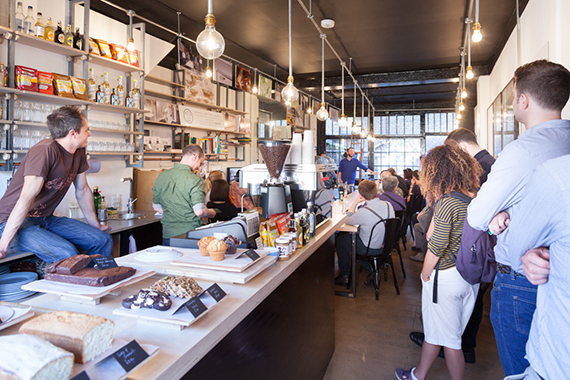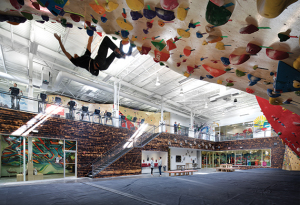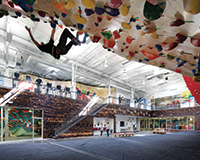 When you sit down in The Common E2, the first thing that strikes you is the powerful scent of the jasmine-infused green tea, as your loose-leaf brew is poured from the pot.
When you sit down in The Common E2, the first thing that strikes you is the powerful scent of the jasmine-infused green tea, as your loose-leaf brew is poured from the pot.
After your first sip, you observe your environment and do a double take: you are not surrounded by stock photos of coffee beans framed on the wall, but by A2 plans of buildings, surveying results and 3D models of leisure centres.
Because this is not just a café, despite what the hot drinks and sourdough bread suggest. It is also an architecture studio. The two combined create an increasingly popular choice of working space: the hybrid office.
The rapid evolution of technology has made the concept of a traditional office redundant for some companies. Collaborating on ideas no longer needs to be done with the whole team in the same area, thanks to the new mediums available for linking up with colleagues 24 hours a day.
And comfortably portable technology is not only accessible but a necessity for firms, and eliminates the need to work in a fixed location.
Couple these factors with rents that are increasing faster than inflation and it is clear to see why having traditional office space is seen as an unnecessary expense for some companies.
Yet with the loss of a bustling office environment often comes the loss of a sense of camaraderie and community in the workplace, which in turn can lead to a less satisfied and productive workforce.
An increasingly popular solution to this quandary is to create a hybrid space that can increase income and create its own animated environment.
Mark Sciberras, designer and owner of The Common E2 architecture studio in east London, which doubles as a café, says: “It gives the landlord a bit of comfort because they know they have a proprietor that will generate income from two streams, so it’s less risky for them.”
Johnny Boone, an architect who has done research into hybrid businesses, believes that east London is central to the growth of this new type of working environment.
“A hybrid business is usually developed by independent entrepreneurs and for this you need the rent to be not too high to start with,” says Boone.
“The Bethnal Green and Tower Hamlets area is the cheapest in London and it’s close to Old Street, which is where all the new startups have gone within the past 10 years.”
Here, Estates Gazette takes a look at five pioneering examples of hybrid businesses around the world.
Find out more about the EG Creative Spaces Award here
The coffee shop: casual at The Common E2
In creative industries such as architecture ideas need to be aired in a frank and open environment if they are to become sound strategies.
When Common Ground Workshop chose to relocate in 2014, owner Mark Sciberras decided to create his own open environment where ideas could be discussed with not only colleagues but also members of the public enjoying a cappuccino.
“In 2001, I was inspired by one of my lecturers at Queensland University of Technology, Paula Whitman,” says Sciberras. “She said typical studio models were a thing of the past. Fast forward 15 years and they are a thing of the past, because a studio is not reliant on a fixed premises.”
Not only can an architecture office be enhanced by café culture, but the bustling business of an architecture studio can generate business for a café, says Sciberras. He adds: “When you and your colleagues are here working, it looks busy. I’ve chosen cafés and places to eat on their environment. If a place is empty, it’s not going to be cosy.”
The bar: High spirits at J Wray & Nephew
Spirits group Campari has a history of brand extensions in and around its offices. The company’s Milan headquarters, for example, is one block away from a famous branded restaurant and bar called Villa Campari.
There was therefore only one option for impressing visitors and clients when Campari acquired half of the 27th floor of The Shard for its subsidiary J Wray & Nephew.
“We wanted the whole area to be an expression of the brand,” says Giordana Canali, a spokeswoman for the Italian company.
Spirits are an integral part of the Campari brand and they are literally central to the office space the company has in the Shard. The first thing you see when you arrive is a fully functioning bar that is bustling both at the end of the day and when clients come to visit.
Away from the glass washer, cocktail shakers and optics are conference rooms to one side and an open-plan office on the other side of the bar.
The bar itself, which stocks not only Campari brands, but also those of rivals, has been a “big draw” to clients, according to Canali. It does not act as a direct additional revenue stream for the company
like some other hybrid concepts, however, as it is not accessible to the public and the drinks are free to both employees and visitors.
 The climbing centre: scaling Brooklyn Boulders
The climbing centre: scaling Brooklyn Boulders
The hybrid space at Brooklyn Boulders works on the premise that “physicality stimulates innovation and creativity”, according to Jesse Levin, creator of the firm’s active collaborative workspace.
The US company started life as a typical climbing warehouse in Brooklyn, New York. But it opted for something different for the 40,000 sq ft warehouse it acquired in Somerville, Massachusetts.
Brooklyn Boulders’ Somerville location looks like your typical climbing gym, but at the top of the 22 ft high climbing walls, there is a surprisingly popular co-working space.
Levin says: “I never quite understood why there was such a segregation between your career and working, and going to the gym and community interaction. It made a lot of sense to me to bring it all together.”
The Somerville workspace has already attracted teams from Red Bull, Puma and Uber to the space.
Brooklyn Boulders has recently opened four more hybrid office spaces in Chicago and Queensbridge, New York.
The Museum: Shared interests at The Macsmiths
Apple users are fiercely brand loyal. Few people know this better than Paul Davis, who over the years has amassed one of the world’s largest collections of Macintosh computers and turned his Hackney office space into a museum of his collection.
Davis’s business of repairing Macs past and present was born during the economic crash of 2008.
“The creative industry that I was involved in collapsed. I’ve always worked on my own Macs and so the idea here was, ‘Okay, let’s get money to put food on the table, otherwise I’m gonna starve’,” he explains. “I started putting some ads up locally, saying, ‘I heart Macs’. Things kicked off quickly.”
To add a unique element to his office, Davis quickly decided to start displaying his collection of Macs and suddenly his repair office became the stuff of legend. “I’ve seen my collection discussed by people in forums. Some items in my collection can’t possibly be unique, I know, but I certainly have
never seen them in anyone’s drawer,” he says.
The curiosity shop formula for Davis’s Mac repair offices seem to be a hit. He is now exploring options for adding a pop-up Macsmiths in south London.
The Art studio: Communal creativity at Sips n Strokes
Art studios around the world bill themselves as being a part of the “paint ’n’ sip” industry. But the original studio was Sips n Strokes, which now has nine locations in the US states of Alabama, Tennessee and Georgia.
The Sips n Strokes art studios are home to resident artists that use the area as their own creative space, but also have space that can be hired out for parties, or areas where people can just sip cocktails while wielding their brush on paper or canvas.
Wendy LoVoy opened the first Sips n Strokes in 2003. She uses the studios both to create her own art and to hold classes. “It’s a new experience for the typical night out. It’s amazing to see customers that have no art experience take home a wonderful painting, with a smile on their face.”











